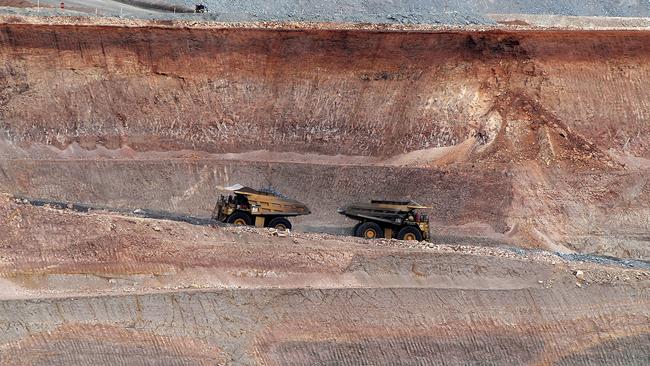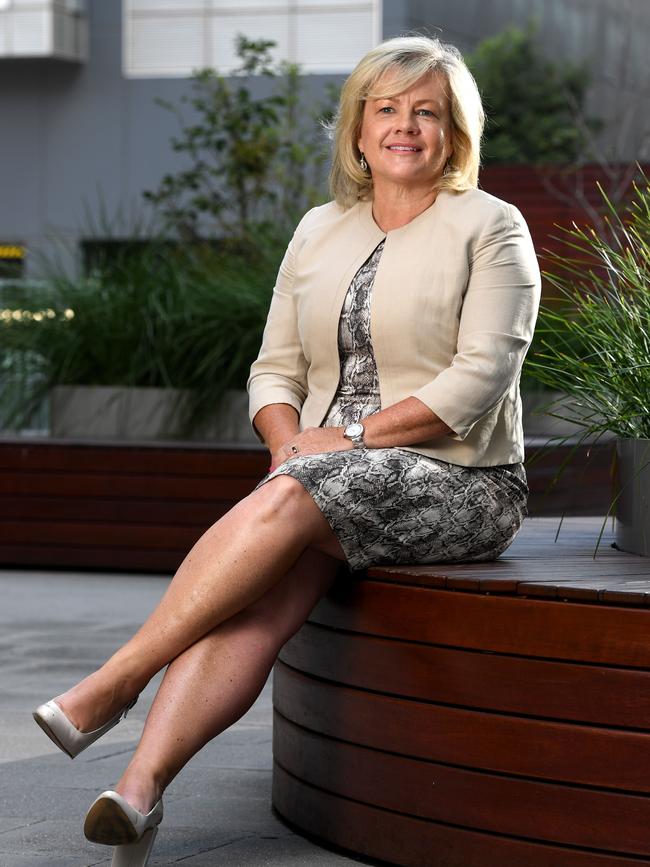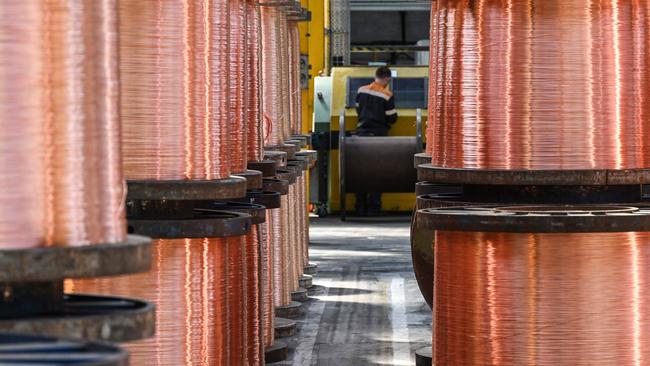
OZ Minerals has reinvented itself to be a largely pure-play copper stock, which despite the price pullback in recent months remains the hottest story in metals when it comes to the transition to clean energy and electric vehicles.
As well as its day-to-day use in pretty much everything the industrial world produces, copper remains an essential ingredient for battery production. That’s the “future facing” minerals where BHP squarely wants to play in and its existing and limited copper expansion options come with a hefty price tag.
BHP made the approach to OZ Minerals’ board on Friday night, with its opening gambit at least hoping to start a discussion around pricing. The problem is BHP has now played an underwhelming card trying to take advantage of the copper price trading at a one-and-a-half-year low. OZ Minerals’ chairman Rebecca McGrath knows other big miners will be running the numbers on its business and this means cashed-up BHP is going to find it hard to walk away from the fire it has started.

OZ’s major asset is its Prominent Hill copper mine, which is located 130km northwest of BHP’s massive Olympic Dam underground copper mine in South Australia. The mine is spitting off cash, has a long life option and offers immediate synergies when it comes to processing the ore and making copper concentrate. More interesting for BHP is OZ Minerals’ Carrapateena copper mine, which is 100km southeast of Olympic Dam and has a projected 20-year mine life. But in the hands of a company with deep pockets like BHP it has the prospect to become a mega copper development.
Combined ownership offers a shared energy grid, staffing and all the costs and higher volumes which immediately brings down production costs. Importantly for BHP, it offers the opportunity for an easy growth option in copper without the logistical challenge or cost of having to remove the millions of tonnes of Olympic Dam overburden.
OZ Minerals also has on its near term development slate the $1bn West Musgrave nickel and copper project that stands to give BHP another near three-decade base metals expansion option to complement its Kalgoorlie smelter which is part of its Nickel West business. Ironically BHP missed its chance when it sold West Musgrave deposits to copper junior Cassini Resources for just $250,000 eight years ago.
To emphasise how much money BHP is sitting on, the bid is all cash and the mining giant has reaffirmed its commitment to its dividend policy to keep investors onside. This comes after several years of shareholders getting used all that cash coming their way. That is the key: deep in BHP’s past is a habit of overpaying for assets. And here Henry is trying to draw a distinction between BHP of old and today’s Big Australian.
OZ Pressures
Still, the $25 per share offer for OZ Minerals represents a 41 per cent premium from its recent 30 day trading — but OZ’s McGrath is betting BHP will want the multi-decade growth more than what the current spot market is pricing copper at. So are the copper miner’s investors after it closed Monday at $25.59, up 35 per cent on the session.
It’s not all smooth sailing for OZ. There is certainly a copper correction underway, and the miner’s shares have come under pressure since its recently quarterly production update which revealed production is falling short through a perfect storm of worker shortages and supply chain squeeze. There also seems to be bottleneck problems impacting Carrapateena production. On the horizon OZ Minerals faces a financing challenge, including potentially taking on more debt to fund the massive West Musgrave development.

BHP’s Henry has suggested some room to move on pricing which is why he openly expressed disappointment at OZ Minerals’ refusal to engage on the cash offer. While cash is easy to come by Henry’s ace card might be coming back with some valuable BHP scrip, a move which will quickly win over OZ Minerals’ shareholders so they can share in the upside.
However unless Henry moves fast, OZ Minerals risks becoming a target of at least three cashed-up big rivals. Glencore and Anglo American both have coal money burning a hole on their balance sheets, while to a lesser extent Rio Tinto could be prepared to enter the fray.
However BHP has calculate that Rio Tinto would be busy given the rival miner currently has a live $4.2bn bid to buy out the remaining stake in Canada’s Turquoise Hill which in turn controls the vast Oyu Tolgo copper mine in Mongolia.
BHP’s approach on a rival mid-tier Australian miner has shades of Rio Tinto’s landmark move on Pilbara iron ore player North Ltd more than two decades ago. There Rio Tinto paid a little under $3bn for a relatively small miner that had a good railway line, was sitting on a higher quality ore resource and had supreme port access.
That acquisition turbocharged Rio’s position in the Pilbara and gave it a platform to deliver tens of billions of dollars of cash back to its own shareholders over the decades.
The question for Henry is: how much does he want to pay for growth?

Suncorp’s digital dawn
For Suncorp chief executive Steve Johnston the digital shift is well underway. Two years ago he challenged his vast insurance business to think more like the banking arm with technology. At the time between 70-75 per cent of his insurance sales were over the phone with as little as 25 per cent of sales online – even for very basic insurance cover. And for claims the figure was higher with 80 per cent over the phone.
Johnston says he challenged his insurance executives to turn the ratios on their head. Initially it was slow going with few believing the heavy personal interaction of insurance would lend itself to the digital world.
“Then along comes the Covid pandemic and all of a sudden, everyone wants to interact with everyone digitally,” he says, adding Suncorp has been spending big to build out its digital insurance platform.

Today through the recent big flooding events in NSW and Queensland as much as 70 per cent of insurance customers were lodging their claims online.
More broadly just over 60 per cent of insurance sales are now through digital channels. With the current momentum Johnston expects this to soon hit 80 per cent of sales. As well as cost savings, the major benefit means that customers aren’t being tied up on telephone queues and they have instant claim approvals. They can also keep track of claims and pick the time for assessors and builders to visit.
Johnston points out in the online world customer expectations are set high. Here Suncorp isn’t being measured against rival Insurance Australia Group, it’s being measured against “Apple and Google and best in market” which shows the importance of doubling down on tech investment.
Fresh from inking last month’s $4.9bn deal to sell Suncorp’s banking arm to ANZ, Johnston is thinking about longer term strategy for his insurance business which also extends to brands including AAMI, GIO, Vero and Suncorp.
Here inflation is emerging as the number one near term risk for the settings he can’t control for his business. Rising prices can make all the difference on the profit line, and the large insurance premium hikes appear to be sticking for now with no material signs that customers are pulling back on coverage or cancelling policies.

For now, Johnston says he is running the business, including the banking arm, as strong as he can given there is a long path ahead and regulatory approval needed before a sale. He points to record sales momentum in insurance premiums which were up 9.2 per cent – including premium hikes – while the bank is running at annualised lending growth at 12 per cent.
Suncorp, which generates 52 per cent of earnings from banking, remains a stark lesson for other companies for this profit reporting season if they disappoint. Suncorp shares fell 4.4 per cent after the insurer’s full year cash profit of $673m missed analyst expectations of $685.5m. A string of large payouts from floods over the past year and poorer investment returns on volatile markets dampened headline results.
Even with the promise of higher returns to come as a pure play insurer and a windfall for shareholders on the bank sale, the market is focused on Suncorp’s short term game.
johnstone@theaustralian.com.au






How much are you willing to pay for the future? That’s the question BHP’s investors will be asking mining boss Mike Henry through his big $8.4bn bet on copper.